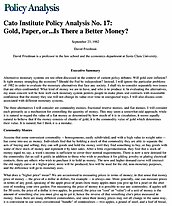The three alternatives I will consider are commodity monies, fractional reserve monies, and fiat monies. I will consider each primarily as a mechanism for controlling the quantity of money. This may seem a somewhat odd approach; while it is natural to regard the value of a fiat money as determined by how much of it is in circulation, it seems equally natural to believe that if the money consists of chunks of gold, it is the commodity value of gold which determines their value. It is natural, but I think it is a mistake.
Gold, Paper, or…Is There a Better Money?
Alternative monetary systems are too often discussed in the context of current policy debates: Will gold cure inflation? Is tight money strangling the economy? Should the Fed be independent? Instead, I will ignore the particular problems of 1982 in order to evaluate the monetary alternatives that face any society. I shall try to consider separately two issues that are often confounded: What kind of money we are to have, and who is to produce it. In evaluating the alternatives, my main concern will be how well each monetary system permits people to make plans and contracts with reasonable confidence that the money they use will not change its value over time in unexpected ways. I will also discuss costs associated with different monetary systems.
About the Author

This work is licensed under a Creative Commons Attribution-NonCommercial-ShareAlike 4.0 International License.
